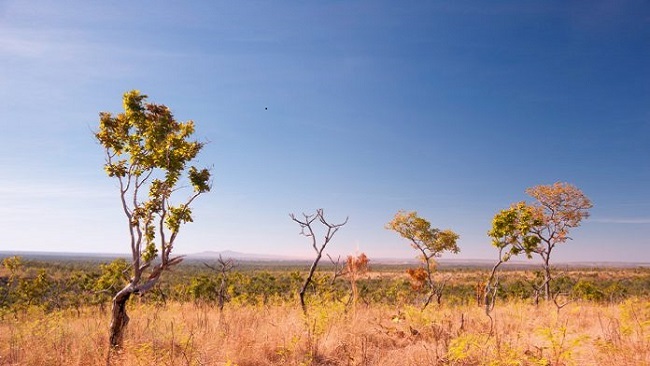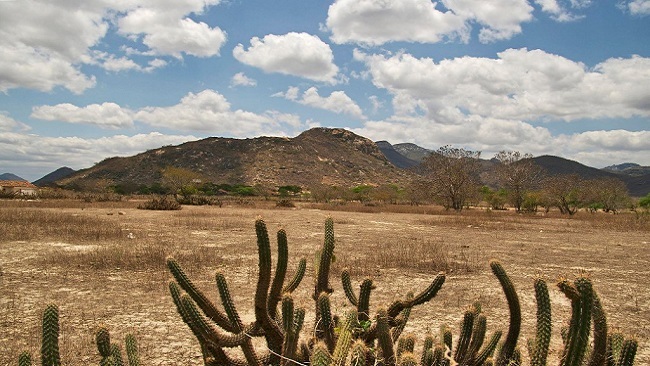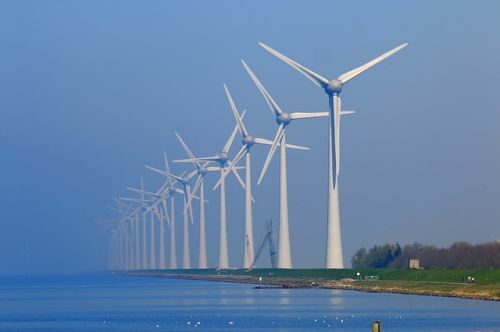Biomes are sets of ecosystems (fauna and flora) that have their own biological and climatic characteristics.
The six continental Brazilian biomes are: Amazon, Cerrado, Caatinga, Atlantic Forest, Pantanal and Pampa, and are located as shown in the image below:

According to data from the Brazilian Institute of Geography and Statistics - IBGE:
- THE Amazon it has an area of 4,196,943 km², occupying 49.29% of the Brazilian territory.
- O thick it has an area of 2,036,448 km², occupying 23.92% of the Brazilian territory.
- THE Atlantic forest it has an area of 1,110,182 km², occupying 13.04% of the Brazilian territory.
- THE Caatinga it has an area of 844,453 km², occupying 9.92% of the Brazilian territory.
- O pampa it has an area of 176,496 km², occupying 2.07% of the Brazilian territory.
- O wetland it has an area of 150,355 km², occupying 1.76% of the Brazilian territory.
Amazon Features
Located in the northwest of the country, the Amazon is the largest and richest Brazilian biome, occupying almost half of the national territory.
It is estimated that 10% of all animal and plant species in the world can be found in the Amazon. This biodiversity is sustained by climatic conditions of heat, humidity, abundance of water (due to rivers and rain) and constant sunlight throughout the year.

The Amazon covers the states of Acre, Amapá, Amazonas, Pará, Roraima and part of Rondônia, Mato Grosso, Maranhão and Tocantins. Internationally, the Amazon also covers parts of Bolivia, Peru, Ecuador, Colombia, Venezuela, Guyana, French Guiana and Suriname.
Given the predominance of the Amazon forest in the region, the greatest environmental risks to the biome are the expansion of the agricultural frontier and deforestation.
Amazon climate
The climate in the Amazon is of the humid equatorial type, as the region is close to the Equator. Rainfall rates are high throughout the year due to the constant presence of water vapor from the rivers.
Fauna and Flora of the Amazon
The Amazon biome is the region with the greatest biodiversity in the world. According to information from the Ministry of the Environment - MMA, data related to Amazonian biodiversity they are always estimates, considering that new species of plants and animals are discovered daily.
Currently, more than 2,500 species of trees and 30,000 species of plants have been catalogued. Regarding fauna, it is believed to be composed of:
- 427 species of mammals;
- 1300 species of birds;
- 300 species of fish;
- 378 species of reptiles;
- 400 species of amphibians.
Among the typical species of the Amazon are: red macaw, pink dolphin, jaguar, surucucu, etc.
Characteristics of the Cerrado
The Cerrado is the second largest Brazilian biome and occupies the central region of the country, encompassing the states of Goiás, Tocantins, Mato Grosso, Mato Grosso do Sul, Minas Gerais, Bahia, Maranhão, Piauí, Rondônia, Paraná, São Paulo and District Federal.

Like the Amazon, the Cerrado is also one of the richest regions in biodiversity in the world. Even so, it is the biome that has the lowest percentage of protected areas, with only 8% of its territory covered by conservation units.
The expansion of the agricultural frontier and the irresponsible exploitation of natural resources made the Cerrado the second region that most underwent transformations in Brazil (after the Atlantic Forest), resulting in the inclusion of 137 species in the list of endangered animals.
Cerrado climate
The climate in the Cerrado is seasonal tropical, with well-defined periods of heat and rain. The average temperature during the year is 24ºC, reaching 40ºC in the hottest months and 0ºC in the coldest months.
In the driest periods (between the months of July and August) the air humidity does not exceed 30%, facilitating the occurrence of fires.
Fauna and Flora of the Cerrado
The Brazilian cerrado is considered the richest savannah in biodiversity in the world. According to data from the Ministry of the Environment, around 11,627 plant species have already been catalogued. With regard to fauna, there are currently around:
- 200 species of mammals;
- 837 species of birds;
- 1200 species of fish;
- 180 species of reptiles;
- 150 species of amphibians.
Among the typical species of the Cerrado are: green-necked hummingbird, savannah jay, plateau turtledove, etc.
Learn more about thick and Characteristics of the Cerrado.
Atlantic Forest Characteristics
The Atlantic Forest is the biome located on the east, southeast and south coast of the country, covering part of 11 states and the entirety of Rio de Janeiro, Espírito Santo and Santa Catarina.

The region is covered by a dense forest composed of medium and large trees. As a result of human exploration, the biome currently owns only 29% of its original territory.
Atlantic Forest climate
The climate in the Atlantic Forest is hot and humid due to air masses coming from the Atlantic Ocean.
Fauna and Flora of the Atlantic Forest
Even with deforestation, the Atlantic Forest still has 35% of plant species in Brazil, with more than 20 thousand cataloged plants.
The Atlantic Forest fauna is composed of:
- 270 species of mammals;
- 850 species of birds;
- 350 species of fish;
- 200 species of reptiles;
- 370 species of amphibians.
Among the typical species of the Atlantic Forest are: golden lion tamarin, capybara, giant anteater, wild dog, etc.
Read more about Atlantic forest.
Caatinga Characteristics
Caatinga is an exclusively Brazilian biome and is located in the northeast of the country, covering the states of Ceará, Bahia, Paraíba, Pernambuco, Piauí, Rio Grande do Norte, Alagoas and Sergipe.

As it is located in a region with long periods of drought, a large part of the Caatinga is marked by desert landscapes, with rocky soil and low fertility.
Caatinga climate
The climate of the Caatinga is tropical semiarid, marked by long periods of drought due to high temperatures and low levels of rain.
Caatinga Fauna and Flora
The Caatinga has rural vegetation, typical of regions with little rain, such as shrubs and cacti. With extended periods of drought, plants lose their leaves and their trunks become dry and twisted.
The fauna of the Caatinga is formed by:
- 178 species of mammals;
- 591 species of birds;
- 241 species of fish;
- 177 species of reptiles;
- 79 species of amphibians.
Among the typical species of the Caatinga are: Ocelot, Opossum, Spix's Macaw, Preá, etc.
Learn more about Caatinga.
Pampa Features
The Pampa is located in the extreme south of the country, covering only the state of Rio Grande do Sul. The region was only officially recognized as a biome in 2004 and consists of a set of plains covered by pastoral fields.

Pampa climate
The Pampa's climate is classified as subtropical temperate, marked by well-defined seasons throughout the year. In general, the temperature is mild and winters are cold, when the occurrence of frost and snow is common.
Fauna and Flora of the Pampa
The flora of the Pampa is basically composed of low-lying vegetation, with more than 450 species of grasses already catalogued and, in all, more than 3000 species of plants. Regarding fauna, it is estimated that in the region there are about 100 different species of mammals and 500 species of birds.
Among the typical species of the Pampa are: perdigão, pampas cat, wild woodpecker, etc.
Learn more about pampa.
Pantanal Features
The Pantanal is the smallest Brazilian biome and is located in the southwest of the country, covering a small region of Mato Grosso and Mato Grosso do Sul.

The Pantanal is the largest floodplain in the world as several climatic and geographic factors hinder the flow of water in the region. Thus, many areas of the Pantanal remain flooded for months, while others remain submerged indefinitely.
Pantanal climate
The climate in the Pantanal is classified as tropical continental, marked by high temperatures. Due to the constant presence of water vapor in the region, rainfall and air humidity levels are always high.
Fauna and Flora of the Pantanal
The Pantanal's biodiversity results especially from changes in water levels during the year. The alternation between periods of drought and long periods of flooding makes the region suitable for the emergence of different types of vegetation. Currently there are more than 1500 species of plants cataloged.
The fauna is composed of:
- 90 species of mammals;
- 600 species of birds;
- 280 species of fish;
- 50 species of reptiles;
- 40 species of amphibians.
Among the typical species of the Pantanal are: maned wolf, capuchin monkey, sloth, wild pig, etc.
Learn more about wetland.
See too:
- Biome
- Legal Amazon
- Geographic space

